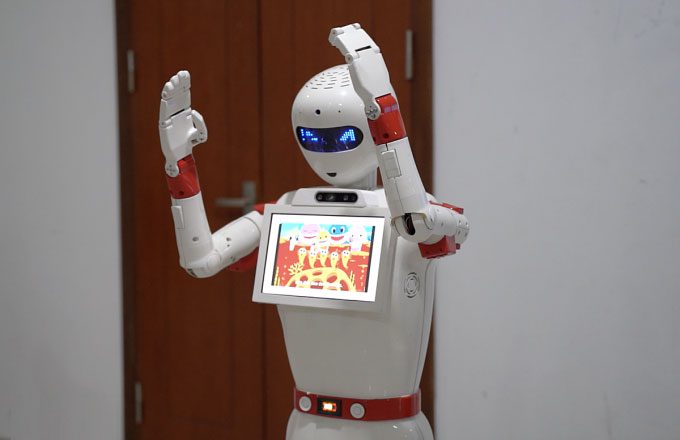Bonbon is a 1.27-meter tall and 40-kilogram robot developed by a team of lecturers from the Military Technical Academy, designed to assist in teaching English, communication, and singing to elementary school students.
The humanoid smart robot that aids in teaching English to elementary school students (Bonbon) is a research project under the National Key Program for Science and Technology until 2025.
The project was proposed by the Military Technical Academy and selected for implementation by the Ministry of Science and Technology. So far, the National Council for Science and Technology has approved and accepted it. The product received a Utility Solution Patent from the Intellectual Property Office in October 2023.
“We are delighted with the success of the project,” said Dr. Le Dinh Son, the project’s leader.
According to him, the product demonstrates that domestic scientists can master the techniques and technologies for designing robots, develop foundational software technologies, and build and solve artificial intelligence problems in sound, image, and natural language processing.
The process of creating the robot by the team of lecturers from the Military Technical Academy. (Photo: Provided by the Academy)
Dr. Son mentioned that he had long desired to design and manufacture a smart robot based on integrating advanced technologies for educational applications.
“Many countries like Japan, China, and South Korea have introduced robots to assist in teaching and learning, becoming effective teaching assistants that help children access knowledge through technology. We hope Vietnam will have such robots,” he shared.
Tasked with implementation since 2020, nearly 20 lecturers from the Military Technical Academy and collaborating units were divided into three groups, responsible for information technology, control, and mechanics.
The challenge from the start was to create a robot capable of autonomous behavior and interaction with humans through speech, eye expressions, or physical gestures using intelligent processing modules.
The main issue was designing and manufacturing the hardware system to create a friendly, humanoid robot suitable for elementary school children. Additionally, the robot can move flexibly, either fully autonomously or via remote control.
Regarding software, the robot must meet requirements for speech, movement, and processing integrated tasks based on artificial intelligence applications in image, sound, gesture recognition, and actions.
The operating system needs to support stable execution of processing algorithms and control programs, especially ensuring real-time synchronization.
“How to enable the robot to talk while moving naturally is the goal our team aims for,” Dr. Son stated.

Dr. Le Dinh Son shares about the Bonbon robot. (Photo: Minh Minh).
The team focused on research in this direction for about two years, sometimes having to meticulously calculate every detail, such as how to ensure that the robot’s arms do not pose safety risks to students, or accurately recognize students’ speech with different accents. Recognizing gestures from interacting individuals to enable the robot to respond appropriately was also a challenging problem.
As a result, the team created a robot approximately 1.27 meters tall and weighing 40 kilograms. Its upper body resembles a human with 21 degrees of movement, including 6 degrees in each arm, 3 degrees in each hand, and 3 degrees in the head. The lower body consists of a mobile module with three omnidirectional wheels, allowing the robot to move freely on a horizontal plane.
“The software modules controlling the robot’s movements are primarily developed based on the Robot Operating System (ROS), integrating and managing various resources and the adjustment of functional blocks quite flexibly,” Dr. Son shared.
Bonbon can perform various teaching scenarios, following teachers’ instructions like presenting content, teaching and practicing vocabulary, teaching new sentence structures, engaging in free conversation on various topics, or singing and dancing.
For example, if a student asks, “Who is Messi?”, the robot will respond in English: “He is a famous football player from Argentina.”
Additionally, Bonbon can pose debate topics, organize games, and cheer when students answer correctly or incorrectly.

Robot Bonbon. (Photo: Minh Minh).
Besides designing and manufacturing, the research team has contacted teachers from elementary schools and foreigners to assist in digitizing materials, creating scripts for lessons, and activities during classes. To obtain voice data suitable for children, they also sought help from Vietnamese students in the U.S.
“This process is very challenging and labor-intensive. Fortunately, the team received enthusiastic support from teachers,” Dr. Son said.
After the Covid-19 pandemic, the research team brought the Bonbon robot to several elementary schools in Hanoi and Bac Kan for testing and feedback to improve the product.
At Nghia Tan Elementary School in Hanoi, the Bonbon robot has assisted English teachers in teaching students to sing, play games, teach vocabulary, sentence structures, and practice speaking with students…
The school representatives evaluated that the robot could provide new utilities and learning materials with a native English accent.
“Both teachers and students are excited about the lessons. Teachers get access to modern technology, students absorb lessons well, and interaction increases. The robot also helps students use English to communicate during class,” she said.
The Bonbon robot dances and answers questions. (Video: Minh Minh).
The testing results show that the robot meets the required features and technical parameters, which Dr. Son believes is motivation for the team to continue researching to enhance operational capabilities, intelligence, and features for broader applications.
“Overall, the robot can support services such as reception, tourism, product promotion, administrative procedure guidance, and directions. This will be the next research direction,” Dr. Son shared.


















































